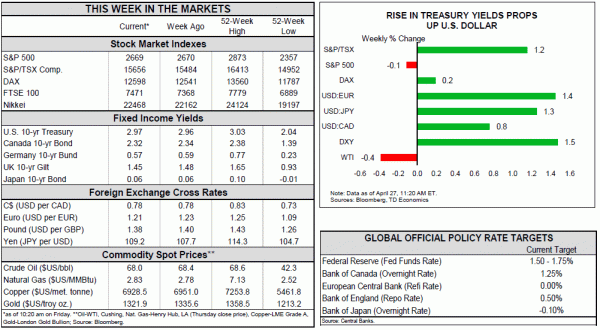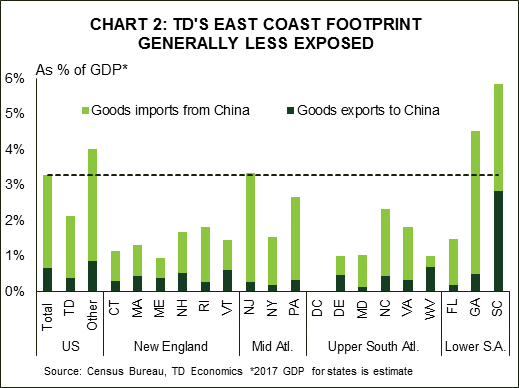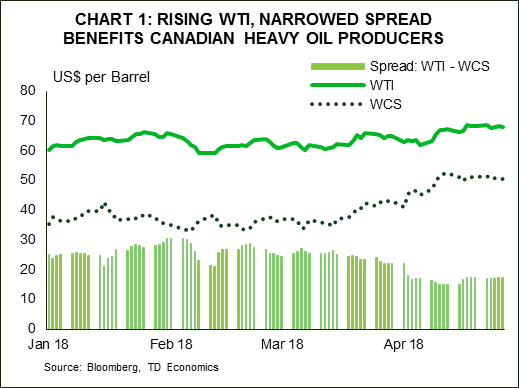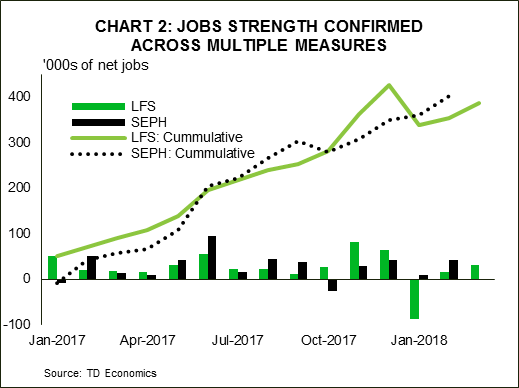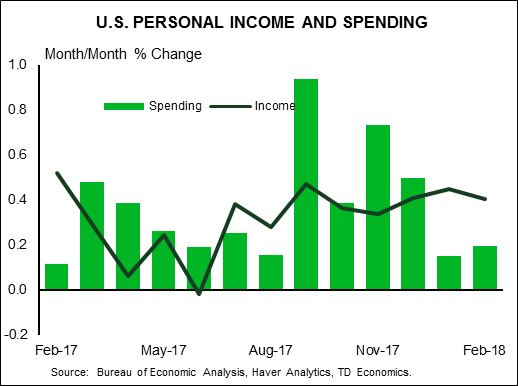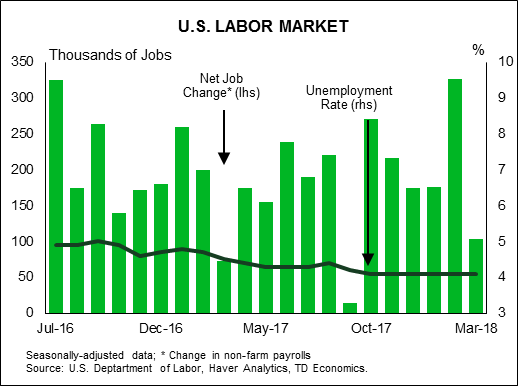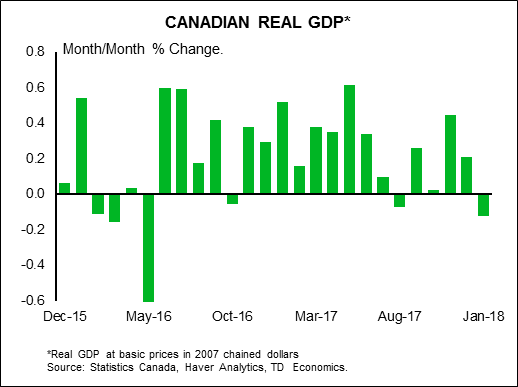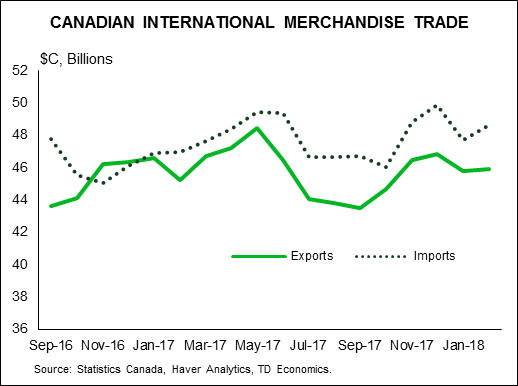U.S. Highlights
- First quarter GDP growth came in at 2.3% (annualized) – slower than fourth quarter growth, but still better than expected. Softer consumer spending was the main culprit behind the slowdown.
- Consumer spending should regain a firmer footing ahead, buoyed by a healthy labor market and tax cuts.
- Rising oil prices accentuated concerns about rising inflation, helping to push the 10-year Treasury yield to the 3% mark. The rise in yields weighed on equity valuations midweek, but a slew of broadly positive earnings reports coupled with the upside surprise on GDP helped markets recover.
Canadian Highlights
- Another week of elevated oil prices helped bring the TSX composite index into positive territory to end the week. The discount received by heavy oil producers remains modest relative to the start of the year, with the benchmark contract holding above $50/barrel for a third week.
- A solid payroll employment report bodes well for monthly GDP next week, but a fairly modest start to the year remains likely. We continue to track Q1 GDP at 1.6% annualized.
- There were encouraging signs of progress on NAFTA negotiations this week, but with a number of contentious issues still unresolved, it seems more likely to be weeks, not days, before an agreement in principle is reached.
U.S. – First Quarter Growth Softens Less than Expected
Over the past few years, first-quarter growth has slowed notably from the fourth quarter, often attributed to a phenomenon known as residual seasonality. This year was no exception. First-quarter growth came in at 2.3% (annualized) – slower than the 2.9% recorded in the fourth quarter, but still better than market expectations for a 2.0% advance. Economic activity was supported by improved business investment, which recorded a solid performance thanks in part to a surge in activity in the petroleum and natural gas sector (+43% Q/Q ann.), and by an unexpected small positive contribution from net trade (Chart 1).
Following a 4% annualized expansion in the fourth quarter that was partly boosted by post-hurricane recovery spending, consumer spending slowed markedly, contributing just a measly 0.7 percentage points to growth. Consumer spending should regain a firmer footing ahead, buoyed by upbeat consumer confidence, a healthy labor market and tax cuts. This narrative is corroborated by stronger monthly spending toward the end of the first quarter, including the surge in March retail sales and a second consecutive monthly gain in existing home sales. The latter rose 1.1% m/m, but the recent performance would have likely been even better if it weren’t for very tight inventories.
Overall, the better-than-expected GDP outturn and healthy outlook ahead may augur a faster pace of rate hikes. But the evolution of price pressures will be the deciding factor. On that front, higher oil prices this week –WTI reached $68/barrel for the first time since late 2014 – accentuated concerns about rising inflation. This helped push Treasury yields higher, with the 10-year yield briefly breaching the 3% mark for the first time since 2014. The rise in yields propped up the trade-weighted U.S. dollar and weighed on equity valuations midweek. But a slew of broadly positive earnings reports, coupled with the upside surprise on GDP, eventually helped markets recover losses.
This week’s selloff reinforces our view that volatility has made a comeback. The return of volatility, something which is likely here to stay, suggests that investors are now responding to, rather than shrugging off, negative news. Perhaps one of the best examples of this reality is the market reaction to elevated trade tensions between the U.S. and China earlier this month.
Ultimately, we believe that there is still time for the U.S. and China to settle their trade differences without much collateral damage – something that appears more likely now with the Treasury secretary scheduled to embark on a trip to China shortly. However, there is still a possibility that the talks fail and tariffs are implemented, with this scenario expected to weigh on economic growth. In a recent report that considers the impact on regional economies, focusing on TD’s East Coast footprint, we find that the Eastern Seaboard is roughly half as exposed to trade with China compared to the rest of the country combined (Chart 2). This would enable most states in the footprint to duck much of the blow from the prospective tariffs. That said, South Carolina’s elevated trade with China leaves it’s economy more vulnerable to the economic drag from protectionist trade policy.
Canada – Getting Closer To ‘Normal’
With little in the way of major economic news, it was a fairly calm week in Canadian financial markets. After a slow start to the week the S&P/TSX Composite Index looks poised to end the week slightly higher on relatively broad-based strength. Helping things along were yet another week of elevated oil prices. The benchmark West Texas Intermediate (WTI) price remained in the high US$60/barrel range, while the Western Canada Select (WCS) contract, representative of what heavy producers in the oil sands receive, remained above US$50/barrel for a third week (Chart 1).
Indeed, recent developments including some restoration of transportation capacity and ongoing issues in Venezuelan production (which produces a similar grade of oil) have helped narrow the price gap between Canadian heavy oil and the benchmark to roughly $17/barrel, well below the roughly $25 to $30 discount that prevailed early in the year. While elevated, the spread is now much closer to the $10 to $15 discount that typically prevails due to quality differences and normal transportation costs.
It wasn’t entirely quiet on the data front this week, with Statistics Canada Survey of Employment, Payrolls and Hours for February released. Although it comes with a much greater lag than the Labour Force Survey (which provides the unemployment rate), economy watchers pay attention to it for several reasons. One is that, since it is based on employer responses (rather than workers), it provides a ‘cross-check’ of the labour market. On this basis, it is encouraging to see that outside of usual monthly differences the trend across the two measures is roughly the same, with employers reporting a faster overall pace of hiring since the start of 2017 (Chart 2).
The other reason to watch this series is that it functions as an input into GDP calculations for a number of industries (particularly service sectors). In the event, the 42.2k rise in payroll employment and slight tick-up in overall hours worked in February bodes well for next week’s monthly GDP report. We look for a 0.3% monthly gain, reversing the weakness of January and consistent with our current Q1 tracking of 1.6%. Looking through the various shocks buffeting the Canadian economy so far this year, the data continues to point to an economy trending around 2%; a reasonably ‘normal’ pace of growth given the business cycle and our economic fundamentals.
The other aspect of ‘normality’ is the potential for a near-term resolution of NAFTA renegotiations. Reports have indicated that the U.S. team hopes to have an agreement in principle by this coming Tuesday (May 1st), in time for Trade Representative Robert Lighthizer’s trip to China. Such a tight timeline, even for just an agreement in principle, seems optimistic. Rules governing the auto sector have been getting most of the attention, with indications that the teams are close to a conclusion. However, a number of contentious issues are reportedly still unresolved, including investor-state dispute resolution, supply management, government procurement, and others. As a result, while there are some reasons to be optimistic that this cloud of uncertainty may soon be lifted, the timeline to a conclusion seems more likely to be measured in weeks, not days.
U.S.: Upcoming Key Economic Releases
U.S. Personal Income & Spending – March
Release Date: April 30, 2018
Previous Result: Income 0.4% m/m; Spending 0.2% m/m
TD Forecast: Income 0.3% m/m; Spending 0.4% m/m
Consensus: Income 0.4% m/m, Spending 0.4% m/m
We look for headline PCE inflation to accelerate to 2.0% y/y in March, reflecting a flat m/m print. In line with the CPI report, energy prices will be lower on the month with food prices up a modest 0.1%. We expect a relatively weak 0.1% m/m print in the core PCE, pushing the y/y rate to 1.9% y/y. A move to 2.0% is unlikely given the quarterly data released in the Q1 GDP report, where core PCE recorded a 1.7% y/y increase.
Nominal PCE (personal spending) should post a 0.4% increase in March on a rebound in durables, translating to the reported 1.1% advance in real Q1 real consumer spending. We look through the weakness as temporary since residual seasonality, weather and delayed tax refunds partly contributed to the slowdown. Solid incomes, confidence and tight labor markets also underpin a solid rebound in Q2 back near 3%. We look for a 0.3% increase in March personal income, in line with a robust 3.6% advance in Q1 incomes.
U.S. Employment – April
Release Date: May 4, 2018
Previous Result: 103k; unemployment rate
TD Forecast: 210k; unemployment rate: 4.0%
Consensus: 185k; unemployment rate: 4.0%
We expect nonfarm payrolls to bounce back, adding 210k jobs in April. The weak 103k print in March largely reflects a giveback from the blockbuster February gains that were concentrated in construction and certain services categories such as retail trade. We expect a return back toward trend consistent with continued strength across survey indicators (employment surveys, consumer confidence), with some upside as April payrolls tend to beat expectations and outperform ADP employment in particular.
Given the still solid pace of job gains, we expect the unemployment rate to move lower to 4.0% assuming a stable to lower participation rate. We expect average hourly earnings to rise 0.2% m/m, as reference week distortions suggest a high bar for a 0.3% or higher print. That should leave the y/y pace steady at 2.7%, consistent with the prevailing view at the Fed that wage growth remains only moderate.
Canada: Upcoming Key Economic Releases
Canadian Real GDP – February
Release Date: May 1, 2018
Previous Result: -0.1% m/m
TD Forecast: 0.3% m/m
Consensus: 0.3% m/m
Real GDP is forecast to advance by 0.3% in February on a broad increase in goods output while services should make a more modest contribution. Manufacturing will benefit from a rebound in motor vehicle output, as evinced by the sharp increase in factory sales while construction should also make a positive contribution on strength in the residential multi-unit component. Multiple oil sands facilities reduced production in February due to transportation bottlenecks, but these will be offset by a rebound from weather-related outages last month. For services, we expect continued weakness in home sales to drive a decline in real estate while a sharp increase in financial market volatility may weigh on the financial sector. Wholesales sales were also down sharply on the month, but strength in hours worked suggests momentum remains solid outside these industries. A 0.3% print would be consistent with Q1 growth in the mid to high 1% range, slightly above the Bank of Canada’s 1.3% projection from the April MPR.
Canadian International Trade – March
Release Date: May 3, 2018
Previous Result: -$2.7bn
TD Forecast: -$2.3bn
Consensus: -$2.0bn
The international merchandise trade deficit is forecast to narrow to $2.3bn in March, reflecting a sharp increase in goods exports offset by more modest import growth. Export growth will be led by agricultural products after transportation bottlenecks led to an unprecedented 17% decline in February, concentrated in grains. CAD depreciation should also lend a hand, with the cumulative decline from the Q1 highs reaching 6.7% by mid-March. However, energy products represent a downside risk on maintenance shutdowns that were pulled forward due to market conditions. On the other side of the ledger, imports should see a more modest increase after a 1.9% advance in February. Aircraft should make a positive contribution on strong Boeing deliveries though the deceleration in core retail sales will weigh on consumer goods imports.




